小编给大家分享一下C++数据结构中list的示例分析,希望大家阅读完这篇文章之后都有所收获,下面让我们一起去探讨吧!
list相较于vector来说会显得复杂,它的好处是在任意位置插入,删除都是一个O(1)的时间复杂度。
template <class T>
struct __list_node {
typedef void* void_pointer;
void_pointer next;
void_pointer prev;
T data;
};这个是在stl3.0版本下的list的节点的定义,节点里面有一个前指针,一个后指针,有一个数据data。这里只能知道他是一个双向链表,我们可以再稍微看一下list关于它的构造函数。
class list --> list() { empty_initialize();
void empty_initialize() {
node = get_node();
node->next = node;
node->prev = node;
}再看一下它的list(),可以看出他调用的empty_initialize(),是创建了一个头结点,并且是一个循环的结构。
综上:list的总体结构是一个带头循环双向链表
迭代器通常是怎么使用的,看一下下面这段代码。
int main()
{
list<int> l;
l.push_back(1);
l.push_back(2);
l.push_back(3);
l.push_back(4);
l.push_back(5);
l.push_back(6);
list<int>::iterator it = l.begin();
while (it != l.end())
{
cout << *it << " ";
it++;
}
cout << endl;
return 0;
}我们从list< int >当中定义一个iterator对象,然后让他去访问我们的节点
并且他所支持的操作有++,解引用,当然还有 --等等
stl3.0当中的迭代器实现:
template<class T, class Ref, class Ptr>
struct __list_iterator {
typedef __list_iterator<T, T&, T*> iterator;
typedef __list_iterator<T, const T&, const T*> const_iterator;
typedef __list_iterator<T, Ref, Ptr> self;
typedef bidirectional_iterator_tag iterator_category;
typedef T value_type;
typedef Ptr pointer;
typedef Ref reference;
typedef __list_node<T>* link_type;
typedef size_t size_type;
typedef ptrdiff_t difference_type;
link_type node;
__list_iterator(link_type x) : node(x) {}
__list_iterator() {}
__list_iterator(const iterator& x) : node(x.node) {}
bool operator==(const self& x) const { return node == x.node; }
bool operator!=(const self& x) const { return node != x.node; }
reference operator*() const { return (*node).data; }
#ifndef __SGI_STL_NO_ARROW_OPERATOR
pointer operator->() const { return &(operator*()); }
#endif /* __SGI_STL_NO_ARROW_OPERATOR */
self& operator++() {
node = (link_type)((*node).next);
return *this;
}
self operator++(int) {
self tmp = *this;
++*this;
return tmp;
}
self& operator--() {
node = (link_type)((*node).prev);
return *this;
}
self operator--(int) {
self tmp = *this;
--*this;
return tmp;
}大家感兴趣可以先看看上面的,我们先用一个简述版的来带大家简要实现一下
template<class T>
class __list_node
{
public:
__list_node(const T& val = T())//用一个全缺省比较好
:_next(nullptr)
,_pre(nullptr)
,node(val)
{}
public:
__list_node<T>* _next;
__list_node<T>* _pre;
T node;
};
template<class T>
class __list_itertaor//这里是迭代器
{
public:
typedef __list_node<T> Node;
__list_itertaor(Node* node)
{
_node = node;
}
bool operator!=(const __list_itertaor<T>& it)
{
return _node != it._node;
}
__list_itertaor<T>& operator++()
{
_node = _node->_next;
return *this;
}
T& operator*()
{
return _node->node;
}
private:
Node* _node;
};这里的实现是不完整的,但是很适合说明问题。通过我们去重载opertaor++,和重载opertaor*,可以让我们像指针一样去访问一个节点,让我们可以跟vector和string一样用同样的接口就能实现对数据的访问,这是非常厉害的一个技术。
注意点:
我们通过对节点的操作,重载了operator++等接口实现了对一个节点的访问,访问的时候实际上也就是创建迭代器对象,对我们的数据进行访问,所以我们封装的时候是将节点的指针进行封装。
list相比vector,正因为他们的底层结构不相同,list的迭代器在插入操作和接合操作(splice)都不会造成迭代器失效,只有删除的时候,只有那个被删除元素的迭代器失效,而不影响后面的,而vector就统统失效了。
模板参数为什么是三个
有这样一种情况,我们需要const对象去遍历,假如我们有个函数叫做print_list(const list< int >& lt);
传参: 其中传参中const是因为不会对对象进行修改,加引用是因为不用深拷贝,提高效率。
功能: 这个函数就是去打印链表里面的内容的。但是按照我们上面的实现,会出现什么问题呢。
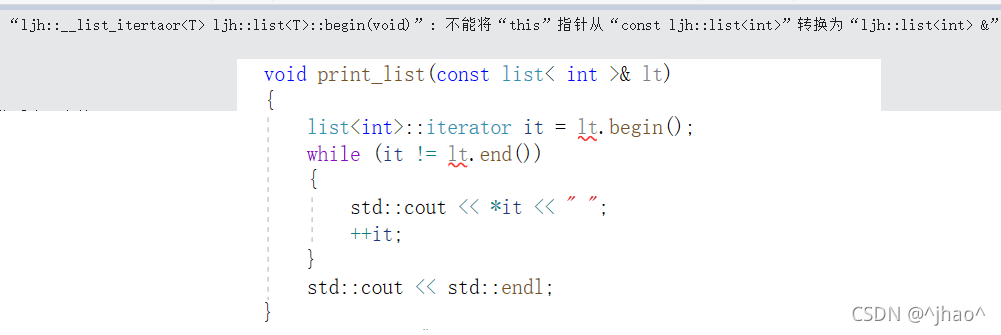
这很正常,在const迭代器就去生成const迭代器对象,在vector,string这些迭代器就是原生指针的时候我们只需要typedef const T* const_iterator,那如果我们在我们生成的list也做类似的操作,来看看结果。
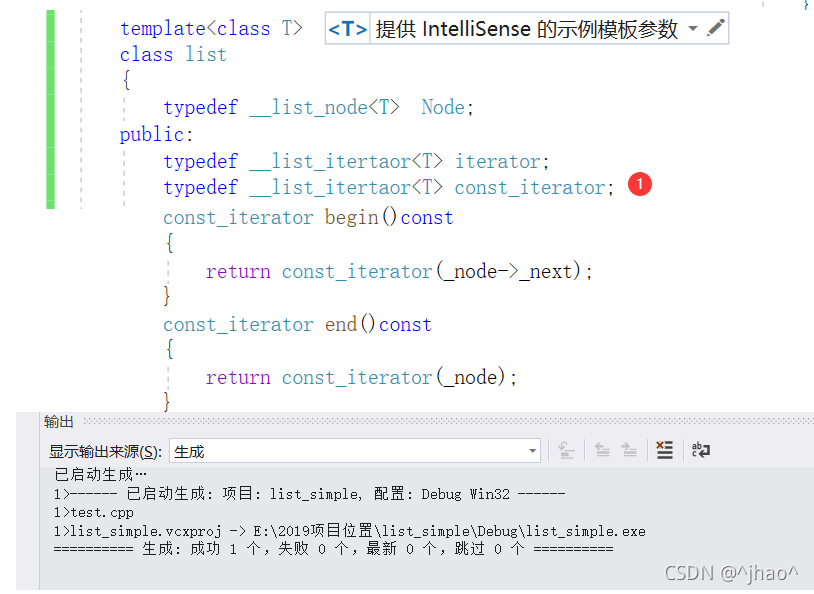
结果我们发现,好像没多大问题,但是我们尝试修改const迭代器里面的内容时,却发现能修改成功。const迭代器怎么能修改里面的数据呢?这就有问题了!!!说明我们的有一个巨大的隐患在里面。

最简单的方法当然就是再写多一个迭代器,把__list_iterator换成__list_const_iterator 之类的,但是我们认真观察的话,实际上这两个类很多东西是重复的,只有在operator*,operator->时所需要的返回值,我们需要找到一种方法去让const对象的返回值也是const对象,答案就是添加多两个个模板参数。
以下以添加一个模板参数为例,实现一个Ref operator*();
template<class T>
class __list_node
{
public:
__list_node(const T& val = T())//用一个全缺省比较好
:_next(nullptr)
,_pre(nullptr)
,node(val)
{}
public:
__list_node<T>* _next;
__list_node<T>* _pre;
T node;
};
template<class T,class Ref>
class __list_itertaor
{
public:
typedef __list_node<T> Node;
__list_itertaor(Node* node)
{
_node = node;
}
bool operator!=(const __list_itertaor<T,Ref>& it)
{
return _node != it._node;
}
__list_itertaor<T,Ref>& operator++()
{
_node = _node->_next;
return *this;
}
Ref operator*()//返回Ref,返回值就有区别啦
{
return _node->node;
}
private:
Node* _node;
};
template<class T>
class list
{
typedef __list_node<T> Node;
public:
typedef __list_itertaor<T,T&> iterator;
typedef __list_itertaor<T, const T&> const_iterator;//修改
iterator begin()
{
return iterator(_node->_next);
}
iterator end()
{
return iterator(_node);
}
const_iterator begin()const
{
return const_iterator(_node->_next);
}
const_iterator end()const
{
return const_iterator(_node);
}
list()
{
_node = new Node;
_node->_next = _node;
_node->_pre = _node;
}
void push_back(const T& val)
{
Node* newnode = new Node(val);
Node* tail = _node->_pre;
tail->_next = newnode;
newnode->_pre = tail;
newnode->_next = _node;
_node->_pre = newnode;
}
private:
Node* _node;
};一图了解:也就是我们的测试端test函数中定义list< int >::const_iterator cit= l.begin();的时候迭代器对象就会识别到定义的const迭代器,它的第二个模板参数放的就是const T&,这样子我们operator*()返回的时候只需要返回第二个模板参数就可以了。
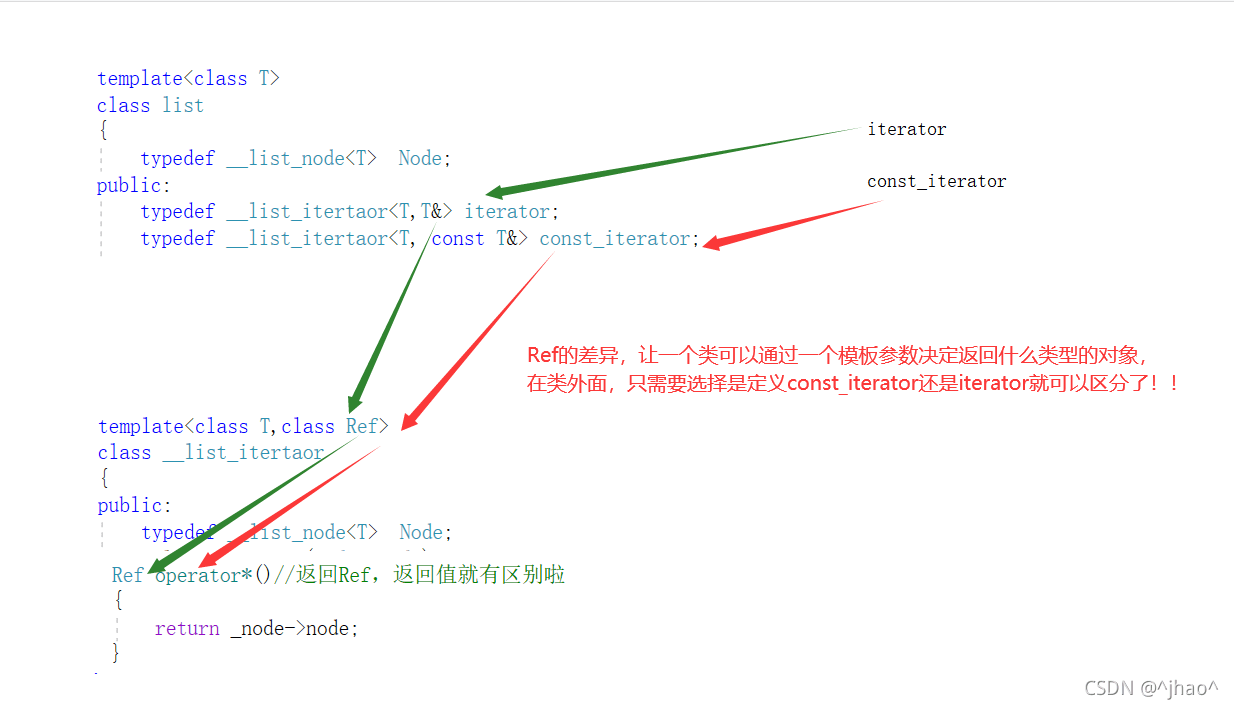
同理,我们要用到的接口operator->当中也会有const对象和普通对象调用的情况。我们这里把实现的代码放出来,有需要的自取。
–》码云链接《–
list上面说的仿佛都是优点
任意位置的O(1)时间的插入删除,迭代器失效的问题变少了。但他又有哪些不足呢
不支持随机访问
排序的效率慢,库中的sort用的是归并排序–>快排需要三数取中,对于链表来说实现出来效率也低,所以当链表的元素需要进行排序的时候,我们通常也都会拷贝到vector当中,再用vector当中的排序。
同理链表的逆置效率也不高!
迭代器从功能角度来看的话分为:const迭代器/普通迭代器 + 正反向。
从容器底层结构角度分为:单向,双向,随机。
单向: 单链表迭代器(forward_list)/哈希表迭代器;这些只支持单向++;
双向: 双链表迭代器/map迭代器;这些支持的++/- -操作;
随机迭代器: string/vector/deque;这些是支持++/- -/+/-操作的,类似原生指针一般。
我们来看一下部分函数的,比如sort当中的模板参数写成RandomAccessIterator,就是想要明示使用者他这里需要的是一个随机的迭代器,在它的底层会调用到迭代器的+操作,所以这个时候如果你传的是一个双向或者单向的迭代器就不行了!!
//sort的函数声明 template <class RandomAccessIterator> void sort (RandomAccessIterator first, RandomAccessIterator last); custom (2) template <class RandomAccessIterator, class Compare> void sort (RandomAccessIterator first, RandomAccessIterator last, Compare comp);
比如说reverse函数声明,它的模板参数是BidirectionalIterator,也就是需要一个支持双向的迭代器,这个时候其实我们就可以传随机迭代器和双向迭代器,从上面的迭代器支持的操作可以看到,随机迭代器是支持双向迭代器的所有操作的。
同理,如果是一个需要单向迭代器的地方,我们就可以传一个双向,随机,单向迭代器了!!
std::reverse template <class BidirectionalIterator> void reverse (BidirectionalIterator first, BidirectionalIterator last);
从stl3.0当中的stl_iterator.h,我们可以看出当中的继承关系。这个我们之后再讲。

注意:difference_type为两个迭代器之间的距离。类型ptrdiff_t为无符号整形。
当我们实现了自己的数据结构,如list,我们如果用库里的std:find查找我们实现的数据结构当中的数据会报错。博主的测试版本为vs2013,在其他版本可能不做检查,不会报错。
void test_list()
{
list<int> l;
l.push_back(5);
list<int>::iterator it = std::find(l.begin(), l.end(), 5);
}报错:这里的报错说的是iterator_category不在我们的迭代器当中,这个是对我们迭代器类型的一个检查。

stl_list.h当中为迭代器添加了如下声明来解决这个问题。
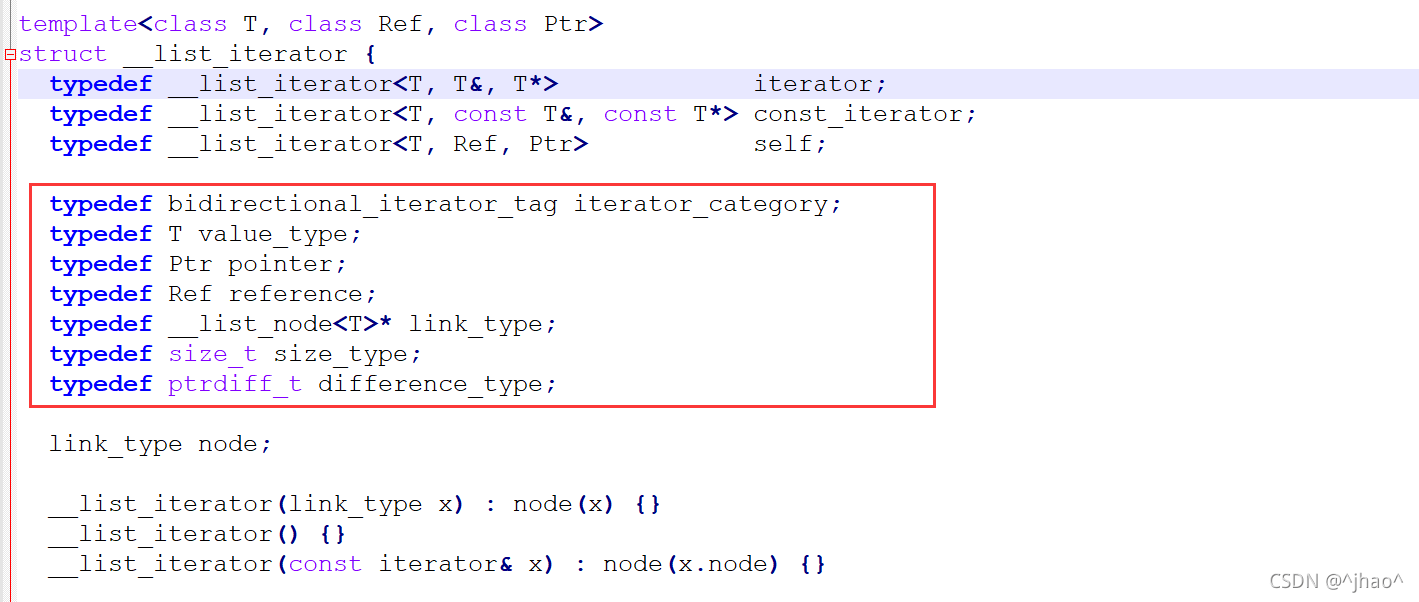
解决方案: 我们可以用stl3.0版本下stl_list.h当中的迭代器的声明。也可以用release版本下,都是可以跑过的。
typedef bidirectional_iterator_tag iterator_category; typedef T value_type; typedef Ptr pointer; typedef Ref reference; typedef ptrdiff_t difference_type;
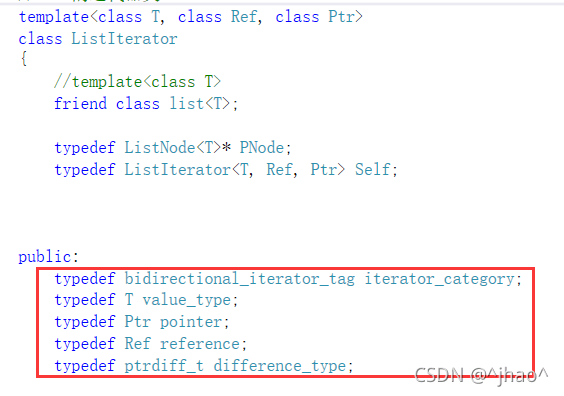
看完了这篇文章,相信你对“C++数据结构中list的示例分析”有了一定的了解,如果想了解更多相关知识,欢迎关注亿速云行业资讯频道,感谢各位的阅读!
免责声明:本站发布的内容(图片、视频和文字)以原创、转载和分享为主,文章观点不代表本网站立场,如果涉及侵权请联系站长邮箱:is@yisu.com进行举报,并提供相关证据,一经查实,将立刻删除涉嫌侵权内容。